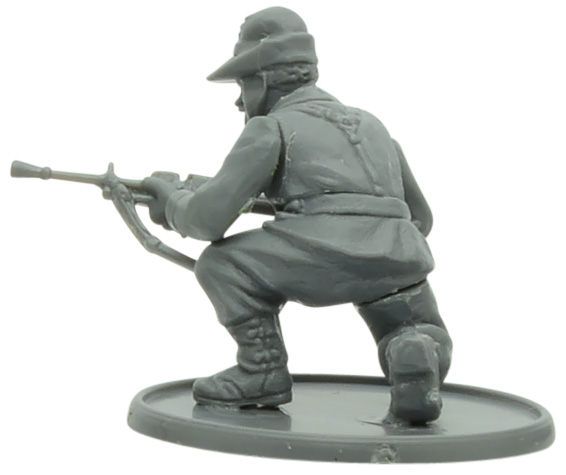
We’ve previously talked about how versatile the Bolt Action infantry kits are. Each sprue can produce a dizzying array of customisation possibilities, which multiplies exponentially when you combine them with other kits. In doing so you can craft some truly unique miniatures, very easily and entirely from plastic, and truly make your army your very own.
Now that we have three separate Italian plastic infantry sprues, the Italian Army/Blackshirts, Bersaglieri, and Alpini mountain troops, and with rules for both Allied and Axis post-armistice Italians present in the recently released Campaign Italy: Tough Gut, I was challenged with kitbashing some Italians for games set after September 1943.
These kitbashes represent soldiers with mixed kit, where they were forced to make use of whatever was available – perhaps with weapons liberated from the battlefield or equipped by their allies in the face of their own ever-dwindling supplies.
Italian Liberation Corps (CIL)
Following the Italian surrender in late 1943, General Umberto Utili would go on to serve the new Allied-aligned Kingdom of the South. Commanding the Corpo Italiano di Liberazione (CIL, or ‘Italian Liberation Corps’), his men would serve alongside the Allied effort, using Italian equipment and uniforms.
An example of an Italian soldier in allied service and equipped with British gear. The Lee Enfield rifle, helmet and backpack are taken from the British & Canadian Army Infantry sprue.
This model uses a similar idea, but this one carries a light mortar. The map is also taken from the British & Canadian Army infantry sprue.
This is by far the simplest of all the conversions, representing a CIL Alpini, made simply by attaching the iconic alpini feather to otherwise British kit.
In a similar vein, this represents a proud NCO who has been forced to use British Uniform but has retained his officer’s hat to commemorate his former service. In this case, the body and equipment are all from the British/Canadian frame, and the head from the Bersaglieri sprue.
Repubblica Sociale Italiana (RSI)
The Armistice and the rescue of Mussolini led to the creation of a new puppet state, with Italian troops that remained loyal to him fighting for the new fascist regime or volunteering their services to the Germans to continue the fight for the Axis.
This model uses an Italian body with the rifle, head and equipment from the German Grenadiers sprue to suggest that this is an RSI soldier who takes his orders and equipment from the Germans.
Another example of a German-equipped Italian soldier, this time with an MG42. The map, head and bullet belt also hail from the German Grenadiers sprue.
An RSI Bersagliere, with a German uniform (from the German Grenadier sprue), but retaining the distinctive feathered helmet and Italian SMG. Both arms are from the Italian sprue.
Another Bersagliere, again with a German Grenadier body.
The same trick can be used with soldiers of Alpini mountain troops. This model again uses a German grenadier body with an Italian SMG and iconic alpini hat.
A second Alpino, this one armed with an Italian LMG.
Try out your own hand at making post-armistice Italian infantry with our trio of Italian plastic infantry Kits:

































3 comments
You should add to the article that those are fantasy models and have nothing to do with history.
Italian RSI were armed sometimes with German Weapons, but retained their (new or old) Italian uniform. They never got German uniforms or helmet.
Italians fighting with the Allies, at first retained their weapons and uniforms, than received British uniforms (keeping although Italian weapons and helmet), then got only British equipment.
I literally came here to comment this. The 1st Motorized Group and Italian Liberation Corps wore italian uniforms and carried italian weaponry, but after it was reformed into the various combat groups of the Italian Co-belligerent Army (in September 1944), the combat groups (essentially divisions) got full british uniforms and weapons, apart from some Beretta smgs still being in service, the italian field caps, and the Alpini/Bersaglieri feathers adorning British helmets. They otherwise were only distinguishable due to collar/shoulder and rank insignia.
Also, I have no idea where the authors got the idea that the 1st Motorized Group was somehow low on morale or performed poorly. Their assault on Monte Lungo was a smashing success and the primary reason they were pulled out of line and expanded into the CIL, thrown back into the fight until Sept 44, then pulled out AGAIN to expand into six combat groups for the future Gothic Line battles. The idea that one of their two national traits is “desertion” is ridiculous, especially given the RSI DID have high desertion rates to the partisans, and yet, doesn’t have that trait. Personally, I’ll be houseruling that out, and probably giving the 1st Motorized Group a more fitting trait to represent their steadfastness and determination at Monte Lungo
I would highly recommend the authors look at this book for a full chapter covering the battle at Monte Lungo:
https://www.amazon.com/Monte-Cassino-Ten-Armies-Hell/dp/0199974640
The Desertion trait isn’t a National trait for the CIL. It’s an option for a special rule for just the base infantry, which did have a problem with desertion early on. But regardless of the credibility of it, it’s just an option for just the infantry squads, and not an overall rule affecting the whole army.
Comments are closed.